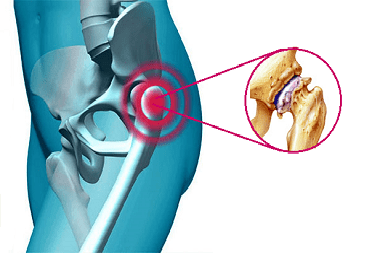Musculoskeletal system >>>> Coxarthrosis of the joints
Coxarthrosis of the joints - causes and principles of treatment.

The defeat of the cartilage tissue of the hip joint, provoked by degenerative - dystrophic changes, deforms the joint, which leads to the development of the disease, which is found in the medical literature under several names: "coxarthrosis of the joint", "deforming osteoarthritis", "deforming arthrosis". The disease of coxarthrosis develops slowly, and not only the cartilaginous tissue of the joint, but also the entire ligamentous apparatus, the joint capsule, the synovial membrane, muscles and intermuscular fascia surrounding the joint are gradually involved in the deformation.
Primary coxarthrosis (an independent disease) often affects the hip joints (two joints at the same time) in old age or with excessive load on the hip joints with excess weight.
Secondary coxarthrosis (a consequence of other diseases) is the result of rheumatoid arthritis, dysplasia, purulent processes in the joint.
There are a number of prerequisites for the development of coxarthrosis of the hip joint:
- Hereditary genetic factors,
- Congenital dislocation of the hip,
- Age-related changes in tissues after 50 years,
- More often the disease is observed in women,
- Decreased physical activity and lack of training of joints for physical endurance,
- Failure of tissue trophism as a result of circulatory disorders in the joint,
- Hip joint injuries,
- Inflammatory processes in the joint area,
- Surgical interventions in the joint area.
The causes of coxarthrosis lie in a gradual change in the physical characteristics of the synovial fluid, which acts as a lubricant and wets the cartilaginous tissue, enabling the latter to retain its cushioning properties. Gradually, the cartilaginous tissue becomes thinner, dries up and stops interfering with the traumatic friction of the articular head and glenoid cavity. The bones of the joint are practically deprived of cartilaginous tissue and begin to deform under the influence of load. In parallel with the destruction of cartilaginous tissue, blood circulation in the blood vessels supplied to the articular block is also disrupted, which in turn leads to a violation of trophism, both of the tissues of the articular apparatus itself and of the surrounding muscles. The muscle tissue of the thigh from the side of the affected joint begins to atrophy.
Signs of joint coxarthrosis:
- Fleeting pain in the joint area,
- Painful sensations arise when moving and subside at rest,
- Temporary inconvenience when driving,
- Gait disorder with a limp,
- Cracking in the joint when moving (in the later stages of the disease),
- Heaviness in the joint area and a feeling of stiffness in movements,
- Atrophic changes in the muscle tissue of the thigh (late symptom).
Treatment of coxarthrosis in the early stages involves conservative therapy:
- Removal of inflammatory processes and pain with non-steroidal anti-inflammatory drugs (Butadion, Nimulid, Ketaprofen, Movalis, Diclofenac, Arcoxia).
- Stimulation of nutrition and restoration of cartilage tissue is carried out using a course of chondroprotectors (Chondroitin sulfate, Glucosamine, Chondrolon, Artra, etc.) - several courses of treatment are required.
- Removal of muscle spasms in the thigh with the help of muscle relaxants.
- Hardware traction of the hip joint - stretching the hip joint in order to dilute the bones of the joint to reduce the load on the cartilaginous tissue.
- Post-isometric relaxation - involves stretching the muscles and tendons.
- Reducing the load on the joint by reducing weight, refusing to carry weights, excluding running, jumping, walking uphill and upstairs without support on the railing from motor exercises, using a cane when walking, transferring support to a healthy joint.
- Wearing orthoses to relieve the load on the hip joint.
- Strengthening the muscles and ligaments of the thigh on special simulators to restore blood circulation and trophism of the tissues of the hip joint.
- A diet high in liquid, foods rich in B vitamins, vitamins C, A, E, trace elements (phosphorus, iron, copper, fluoride), dishes made from broths (jellied meat, aspic, terrine).
- In the later stages of coxarthrosis, intra-articular injections are performed.
Surgical intervention is carried out in cases of ineffectiveness of conservative treatment and in the late stages of the development of coxarthrosis. There is a surgical treatment of coxarthrosis by joint arthroplasty - replacement of the hip joint with a prosthesis (requires long-term rehabilitation).

Read

Read


























